(MENAFN- Asia Times)
The United States and the West have so far failed to force Russia to withdraw its army from the Ukrainian border. For Russia, the best military option will be to enter Ukraine until reaching the Dnieper River in the first stage of its operation. It is easy to quickly stabilize the post-war situation as the east side of the river is greatly influenced by Russia and the Orthodox Church.
The mission has to be completed within three to seven days. Russia should launch its attack in May and June when the melting period has passed, rather than in January and February. The sunshine time is longer while the operations of mechanized equipment and personnel have fewer problems in summer than in severe winter.
The NATO countries do not seem firm in supporting Ukraine as they are still paying Russia for its gas supply. If the US and the West impose sanctions on Russia, they will only push Russia toward China, the world's second-largest economy. (Translator's summary)
Under the continuous provocation of Western countries, the situation in Ukraine has suddenly heated up.
According to some reports, Russia has recently assembled 100,000 troops on the Ukrainian border and held joint military exercises with Belarus. Together with Crimea, it has caused huge military pressure on Ukraine from three directions. The US and Russia have begun talks on the presidential and foreign minister levels but the result has only been“expectation for further talks.”
Ukraine is the second-largest country in Europe by land area, larger than France or Germany.
The straight-line distance from the Ukraine border to Moscow is only about 450 kilometers. By road the distance is 490 kilometers. Since the Orange Revolution in Ukraine, the West has greatly advanced its sphere of influence – but the West doesn't want to bear the burden of Ukraine's weak economy.
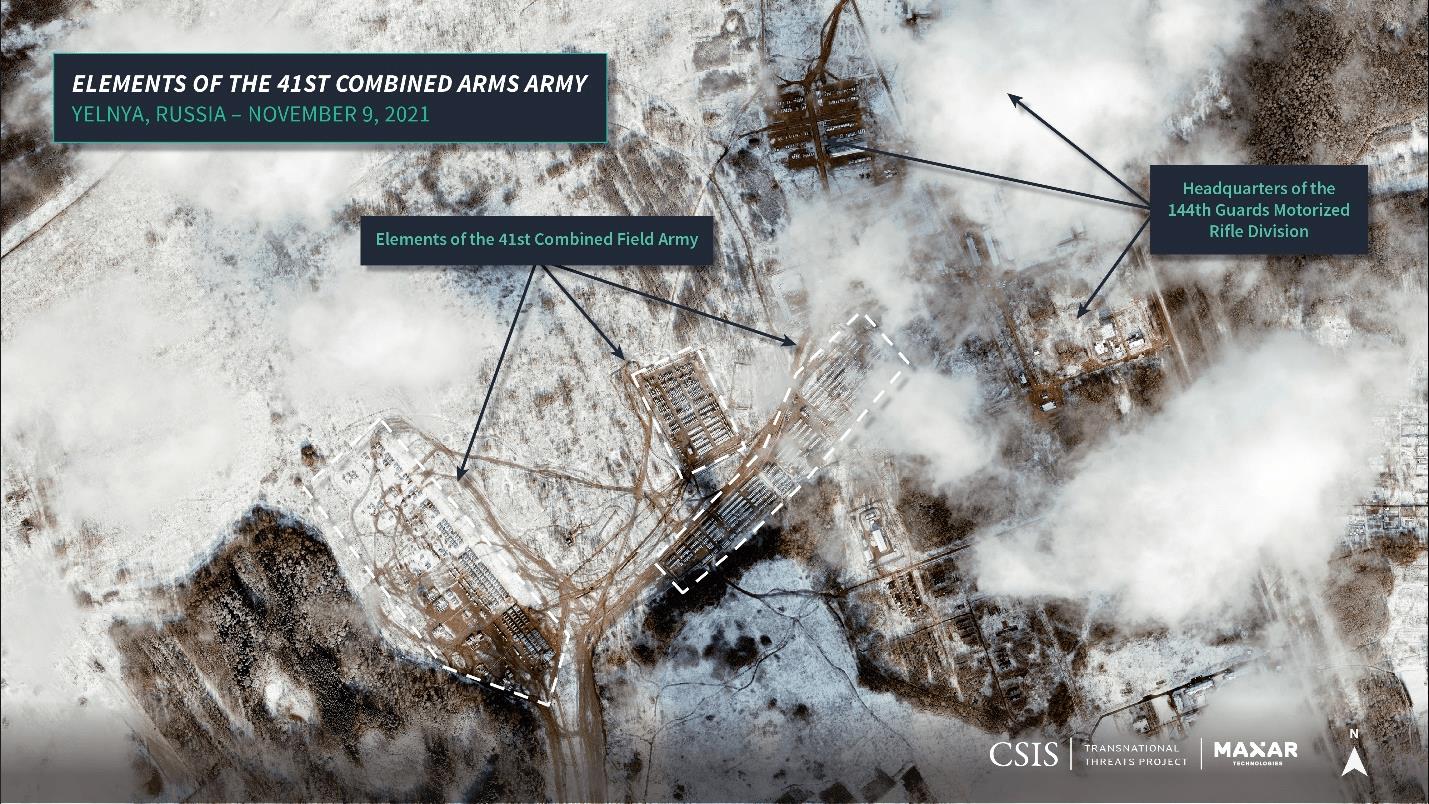
The frequent conflicts in Eastern Ukraine have made Ukraine a hot potato that could be neither held nor thrown away. The Crimea issue has become a predicament for the West: The West has no intention of helping Ukraine retake Crimea – nor of admitting the reality that Russia has taken it. In this dilemma, it is sinking ever more deeply into Ukraine's quagmire and the situation is getting worse and worse.
The West only provides political support to Ukraine verbally, but it does not provide critical economic support. It is providing military support to Ukraine but on a small scale. Now it is focusing on providing military advice and training, plus some Javelin anti-tank missiles.
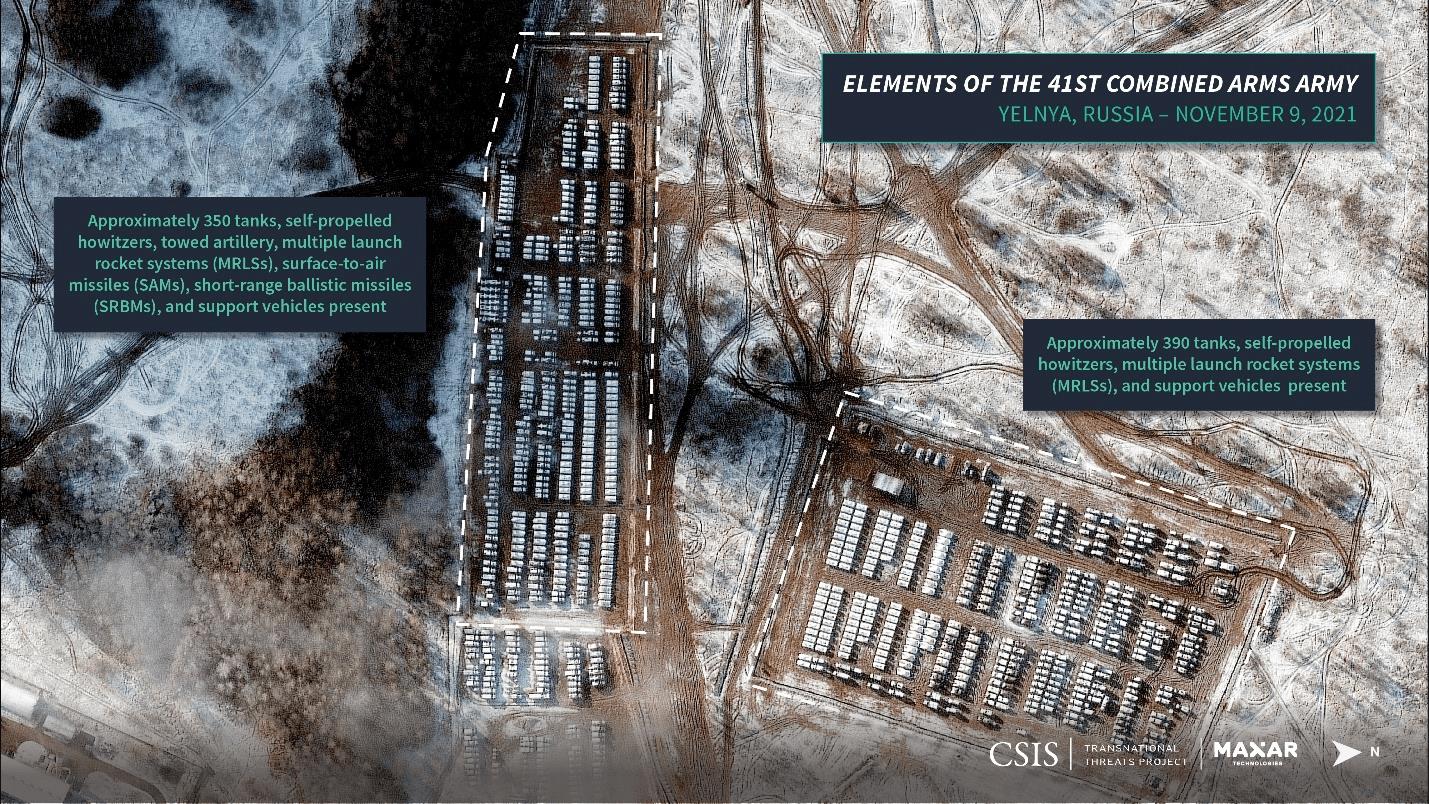
Western military advisers have a limited role in Ukraine. No matter how expert their military knowledge is, their expertise is only compatible with the training, equipment, and command system of their own (or NATO) troops. They may not be useful in Ukraine.
Retraining the Ukrainian army is impossible. The US military had been training the Afghanistan army for 20 years. But in the end, the Afghanistan soldiers fled before the enemy arrived.
In fact, the US has little to do apart from intimidation. Its sanctions will not frighten Putin. The US wants Russia to consider the consequences of military action, but for Russia, there is no more serious consequence than having a Western sword pointed at its head.
The new American script is to repeat that a Russian invasion of Ukraine is imminent in January and February, thereby forcing Russia to deny it. If Russia delays its action, the US will keep changing the timetable in its script so long as Russia does not withdraw its army from the border. If Russia launches an attack, that will prove its previous denials false, putting Russia in the wrong.
It is simply impossible for such a trick to materially influence Russian decision-making. Only Russia can decide whether it should attack. What's more, winter is not necessarily the best season for an attack. In summer, daylight hours are longer, while mechanized equipment and personnel have fewer problems than in severe winter. Operation Barbarossa and the Battle of Kursk both were launched in summer.
The deployment of Russian troops at the border is a reaction to earlier Ukrainian deployments in Eastern Ukraine. Russia cannot sit back and watch the Ukrainian army attack East Ukraine. And Russia has repeatedly stated that it has no intention of taking the initiative for an attack. If Russia is triggered by certain conditions to launch an attack, what military options does it have?
The Russian Air Force is far more powerful than Ukraine's, but aerial warfare is not Russia's forte. In Russia's Georgia operation, airpower was employed only for support. The same would be true in Ukraine. The Russian Navy is even less powerful. The Black Sea Fleet was the country's weakest in the Soviet Union era, and it remains so.
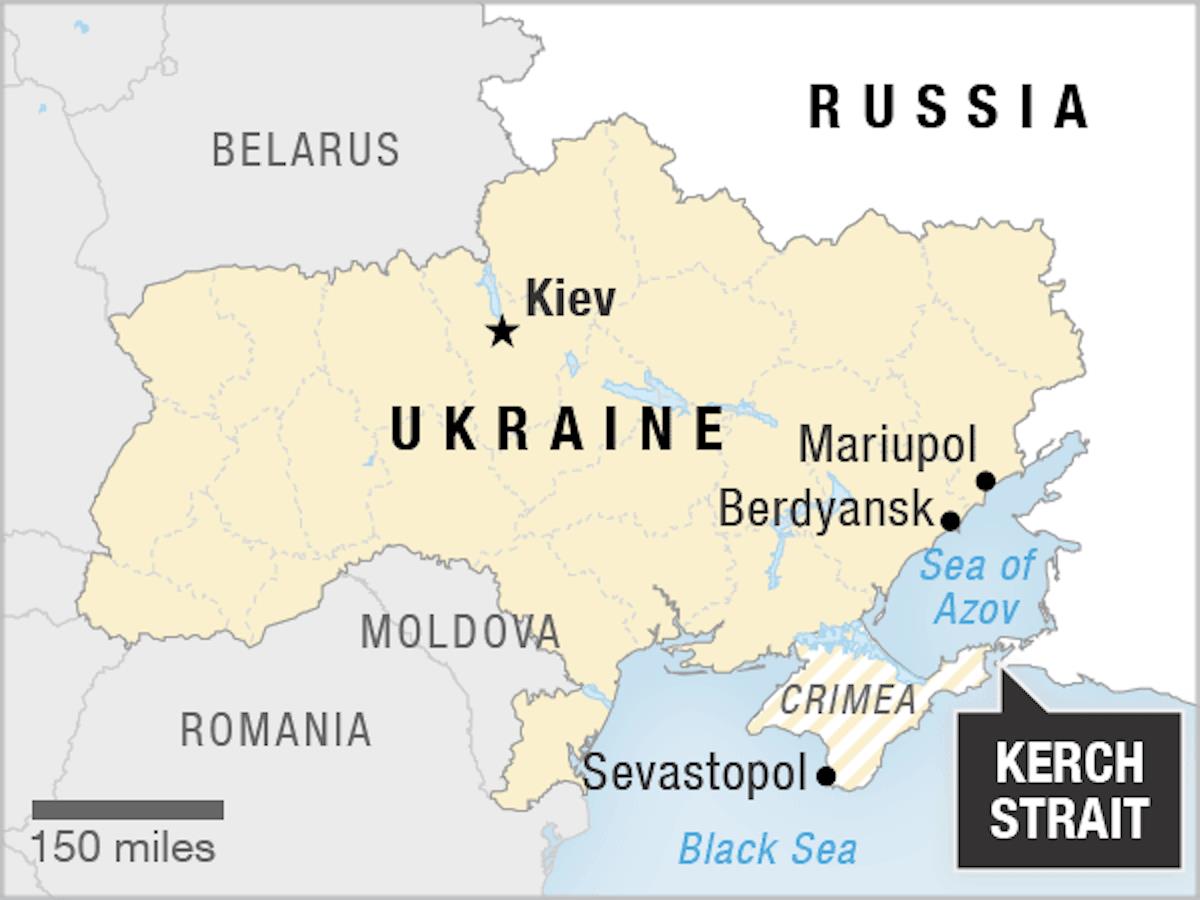
Russia's attack is most likely to be based on land. Not only does the Russian Army have an overwhelming inherent advantage; it also almost surrounds Ukraine, deployed as it is on three sides – that's a positional advantage.
Ukraine's flat terrain is also suitable for the Russian army to use its armor advantageously. In World War II, the Dnieper River did not stop the German attack, nor the Soviet counterattack, and today it is only a convenient geographical line of demarcation.

Speaking of which, the Russian military has six military options, each with different consequences:
1. Temporarily withdraw some troops from the border and focus on diplomatic solutions while continuing to support the Eastern Ukrainian armed forces. That was the state affairs before the Russian army deployed troops to the border. In fact, it is not an option at all. If the matter could be solved diplomatically, we wouldn't have the present situation.
2. March into Donetsk and Luhansk in the name of peacekeeping, and keep the army there until a favorable result for Eastern Ukraine and Russia is reached in peace negotiations. This isn't a likely scenario. With the Russian army positioned at the border, it is unlikely that the Ukrainian army will defeat the Eastern Ukrainian armed forces.
3. Enter Ukraine until Russian forces reach the Dnieper River. The Dnieper River is not only the main geographical demarcation line in Ukraine; it is also the demarcation line of two populations. The west side of the river is influenced by Poland and Roman Catholicism, and the Ukrainian ethnicity is stronger there. The east side of the river is more influenced by Russia and the Orthodox Church, and the ethnic composition is friendlier to Russia. It would be easy to stabilize the situation on the ground following an incursion. This would simply solve the problems in Eastern Ukraine once and for all.
4. March from the Sea of Azov to the coast of the Black Sea while marching along the Dnieper River. In this way, a land bridge would be opened between Russia, Crimea and Transnistria, Ukraine would become effectively a landlocked country, and Crimea would also solve its freshwater shortage.
5. Enter the Azov Sea and the coast of the Black Sea. But this is a flat territory without defensive strong points. It also lacks the rivers and mountains that make it easy to defend the east bank of the Dnieper River.
6. Enter all of Ukraine. Among all the available options, this operation would be the largest in scale and have the greatest political, military and economic impact. It would also place the Russian army directly opposite NATO for the first time since the dissolution of the Soviet Union (apart from the three Baltic States).
In operational terms: If the Dnieper River is the destination, the three main routes will include the northern, central and southern routes. Specific combinations will be determined by the above choices.
The northern route focuses on attacking Kyiv separately. If Belarus cooperates, the Russian army can bypass the Chernobyl area, which is not suitable for transit, and attack Kyiv from the flank and rear. The Novyurkovich-Chernihiv-Kyiv route is about 250 kilometers long, and the Tropotnoy-Konotop-Nizin-Kyiv route is about 320 kilometers long. If the Russian army can pass through Belarus, the Masur-Korosten-Kyiv route is about 250 kilometers long. In an ideal situation, the encirclement of Kyiv can be completed in as few as three days, at most in seven days.
There are three main routes for the central approach: Belgorod-Kharkiv-Poltava-Kremenchuk (about 320 kilometers long) route, the Donetsk route (it can be divided into two: Netsk-Dnipro and Donetsk-Zaporizhzhia, each about 220 kilometers), the Rostov-Mariupol-Bertyansk-Melipol route, with the Dnieper River as the main goal. If the Russian army can bypass Kharkiv and march straight forward, it can also reach the Dnieper in as few as three days, at most in seven days.
The southern route starts from Crimea. The eastern flank and the southern flank of the central route march separately and meet at Melipol, while the western flank advances to the Dnieper estuary of Kherson. Again, the operation can be completed within three to seven days. By itself, however, the logistical route through the Kerch Bridge and Crimea would not easily support a large-scale military operation.
The three-line simultaneous operation would have the largest scale, impact and effect.
If the southern front did not halt at the Dnieper, the advance on the Dnieper could be the first phase of an operation the second phase of which could then be carried out by amphibious assault on Odessa at sea at the same time that Russian forces crossed the Dnieper.
If this should succeed, the north road would open up the land passage with Transnistria (an enclave of ethnic Russians between Moldova and Ukraine), and the southern road would open up the connection with Bujak (south of Moldova, across the bay from Odessa, connected to the National Forest Park with a width of only two kilometers on land, mainly by seawall and bridge at the mouth of the bay). The Russian sphere of influence would then advance to the Romanian border.
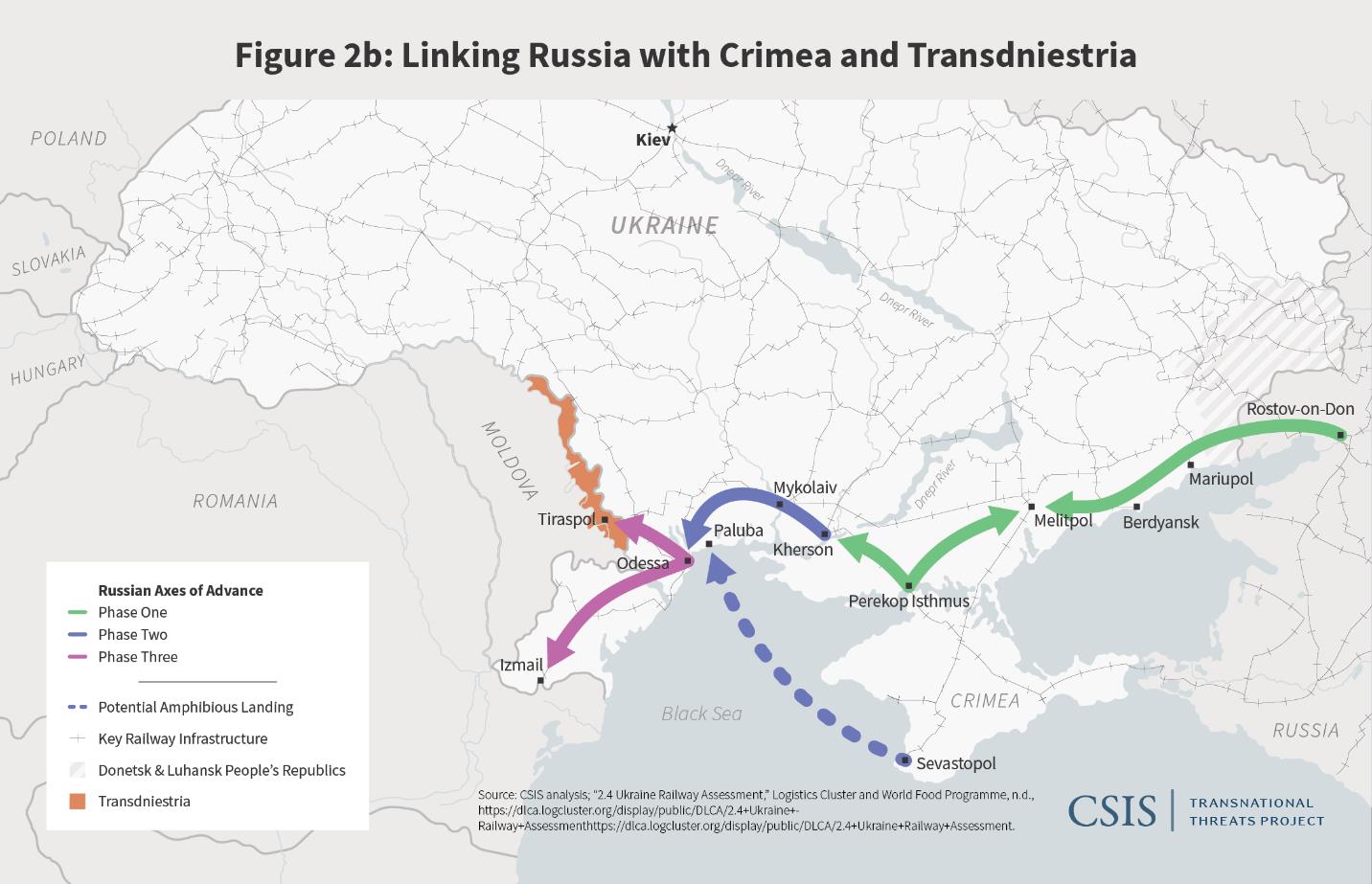
If Russia decided to enter the west bank of the Dnieper River aiming for the whole territory of Ukraine, it would need yet another two-stage operation, with a short stop in the Vinnytsia-Zhytomyr-Korosten line for resupply. It would then continue to advance westward, eventually reaching the borders of Hungary, Slovakia and Poland.
Vinnytsia was an important location in the Great Patriotic War. Hitler's Eastern Front Command, code-named“Werewolf,” was headquartered 12 kilometers north of Vinnytsia and Hitler's code-name was“Wolf.” It was here that Hitler ordered the division of German troops on the southern front respectively into the Caucasus and Stalingrad, and here he oversaw the Third and Fourth Battles of Kharkov.
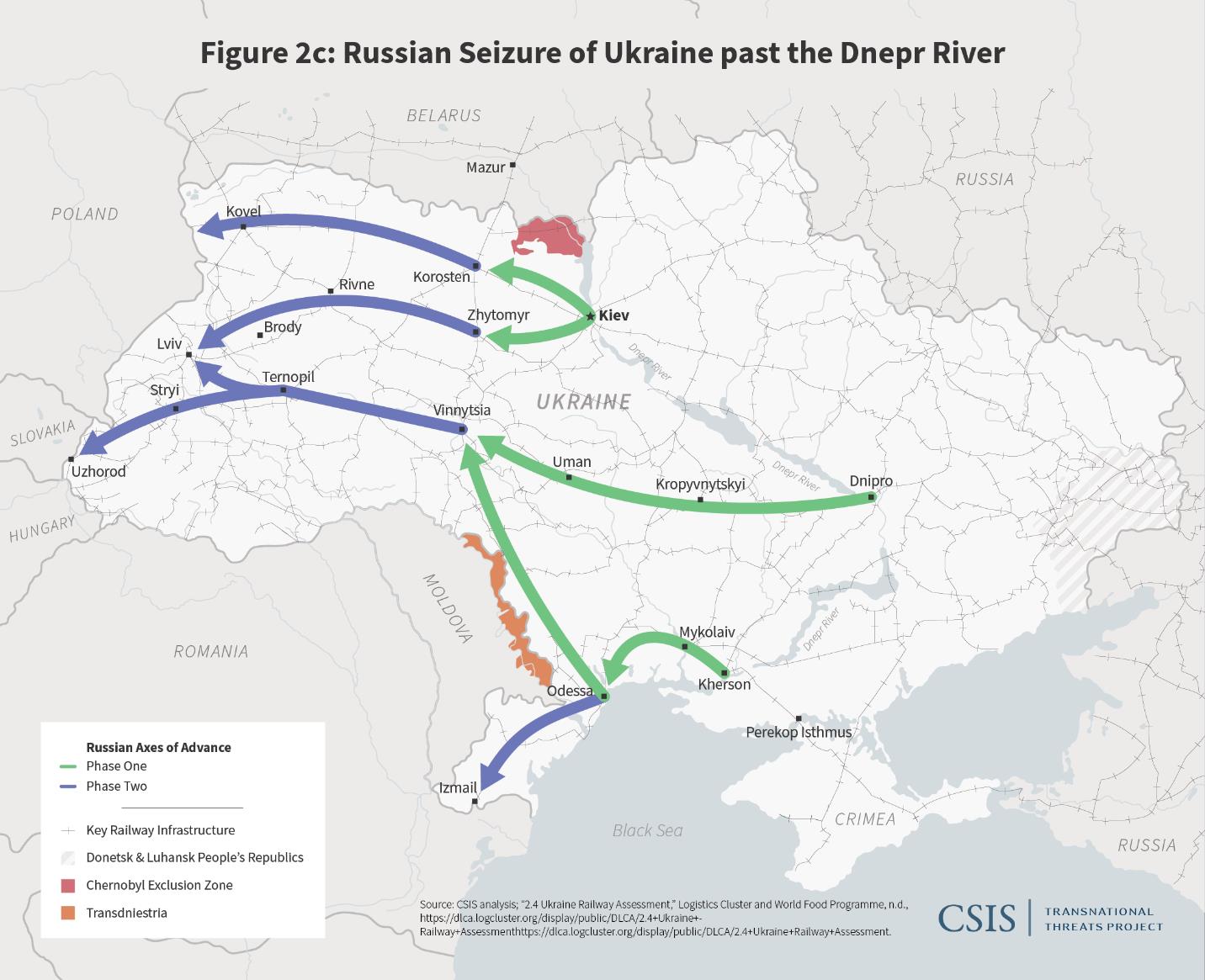
If the Russian army should prove strong enough, with the political cooperation of Belarus it would be possible to combine into one operation the two phases of the advance towards the west side of the Dnieper River. Starting from Belarus, Russian forces could march all the way along the Polish border and cut off the Ukrainian army's retreat and connection with NATO. The other way is to outflank the Vinnytsia-Zhytomyr-Kristen line and join up with the Russian army on the eastern front.
It can be seen that Russian army logistics are still highly dependent on the railway, so the attack route would follow the railway line. Important railway hubs would be the focus of the battles.
The Russian army is good at blitzkrieg. But Ukraine is a very large country, measuring more than 1,000 kilometers from east to west and more than 600 kilometers from north to south, and has a population of 41 million including the cities of Kyiv (3 million), Kharkiv (1.5 million), Odessa (1 million), Dnipro (1 million), Zaporizhzhia (750,000), Mariupol (500,000). They are not small cities.
The Russian army would have to fight quickly, bypass the cities and go straight to the rear. Otherwise, the attack would become a deadlock like the one in Grozny (with only 400,000 people), and Russia would become a passive force.
The time factor mainly depends on the preparation of the Russian army and the resistance of the Ukrainian army. The arrival at the Dnieper front line has to be completed within three to seven days. The mission will fail if it takes longer. Should it“settle” the cities behind the front before advancing? Or should it give up the street fighting and continue to advance at high speed to the western border of Ukraine? Each of these strategies has its own advantages and disadvantages, and it mainly depends on the military resources and operational decisions of the Russian army.
Western commentators argue emphatically that the Russian army will attack when the ground is frozen in January and February, so as to avoid the difficulty of mobilizing mechanized equipment during the thaw after March. This is a very strange argument. The present deployment of the Russian army is a countermeasure to the previous deployment of the Ukrainian army in Eastern Ukraine. It has been in place for some time. If the Russian army wants to take action, January and February will be too late, as the ground already has been frozen for a month. The opportunity for the Russian Army to take action diminishes as the thaw approaches.
On the other hand, the thaw will be over in May and June. The summer is not only dry, but also has longer daylight hours, which are more conducive to operations. In the Great Patriotic War, the Battle of Moscow and the Battle of Stalingrad all started in summer. The German army had become stationary. It was defeated after its military action was delayed until the severe winter due to the resolute resistance of the Red Army.
Although the US and the West can provide the Ukrainian army with air defense, anti-tank and anti-ship missiles, electronic warfare, light weapons, artillery, ammunition, vehicles, aircraft spare parts, fuel, supplies and medicine, it would take time for Ukraine to upgrade its combat power. We are no longer in the era of World War II when resistance fighters could fight immediately by picking up submachine guns and explosives airdropped to them.
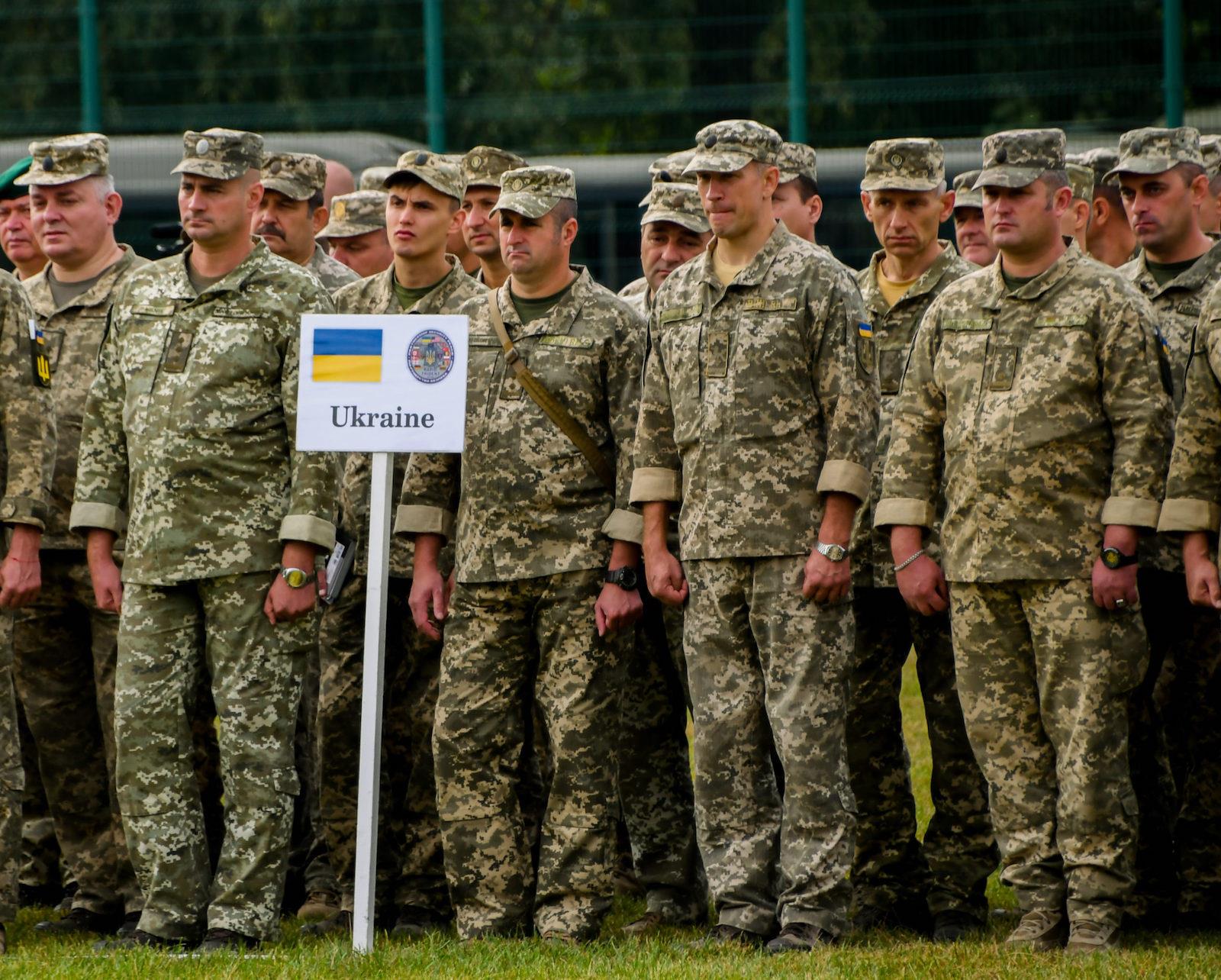
Ukraine soldiers stand in formation for the opening ceremony of Rapid Trident in International Peacekeeping and Security Center, Yavoriv, Ukraine, September 3 2018. Rapid Trident was a Ukrainian-led exercise with multinational support consisting of 14 allied and partner nations. Photo: US Army National Guard / Pfc Andrea Torres
The Ukrainian army, which is familiar with Soviet-made equipment, would need some time to adapt to Western equipment. It is difficult to say whether the Ukrainian army still has enough time.
Or, like the Afghan mujahideen, the Ukrainian army could try to fight an anti-Russian guerrilla war in Ukraine and try to exhaust Russia. It sounds like a great idea, but it's actually not feasible. Ukraine and Russia are too close in terms of culture and blood.
This is a quasi-civil war. It can even be seen as an expansion of the Eastern Ukraine war. There will not be a language and cultural gap for the Russian army when fighting guerrilla battles. During the Great Patriotic War, Ukrainian nationalist armed forces were supported and armed by the German army but achieved nothing.
On the other hand, while America and the West have some political and economic options, none of them will work.
No matter how severe the economic sanctions from the US and the West may be, they will not be enough to fundamentally shake Russia's decision-making. They will only push Russia toward China. China's economy continues to develop at a high speed. Its size, which is the world's second largest and will become number one in the future, is a powerful driving force and a development opportunity for Russia.
Secondly, the war of public opinion that the US and the West are waging cannot hurt Russia, which has been smeared for a long time. Some people may say that NATO countries can provide asylum to Ukrainian refugees and can put moral pressure on Russia, but in fact such a move will help Russia reduce the burden of controlling Ukraine.
At the same time, Ukraine is the main route for Russian gas to Europe, and any military conflict may seriously affect the delivery of Russian gas to Europe. It is possible to supplement European demand with American LNG, but that brings up a strange problem. If NATO countries want to help Ukraine, shouldn't they take the initiative to stop“funding the enemy”? They don't even need to wait until the conflict starts. If NATO is not firm about this position, what kind of support is it talking about?
Of course, the US and the West could try to use diplomatic pressure to force Belarus to refuse to cooperate with Russia, and to refuse to allow the Russian army to pass through. This might have been feasible if the West had not attempted a color revolution in Belarus. The West in effect slaps Belarus in the face with its left hand and pulls Belarus to its side with his right hand. Does that make any sense?
Finally, the West could also resort to the trick of an international tribunal to investigate Russia's supposed“war crimes,” but I personally feel that the subject most worthy of investigation is American war crimes in Afghanistan.
Ukraine has become a difficult problem for the US and the West. Russia is still talking with the US, but it is clear that it will make decisions on its own. The US won't be able to get what Russia doesn't want to give up at the negotiating table. The reverse is also true. Russia won't be able to get what the US doesn't want to give up.
The US cannot force Russia to promise not to attack, and Russia cannot force the US to promise that Ukraine will never join NATO. The stalemate in Ukraine will continue.
America's strategic focus on the Asia-Pacific provides the best moment for Russia to exert pressure on Ukraine. Despite the strong influence of the US, Russia can do whatever it wants in many parts of the world, such as openly developing military cooperation with a Burmese military government that is besieged by the West. It has delivered two Su-30SME heavy fighter jets to Myanmar.
It is also conceivable that Russia might provide fighter jets and anti-aircraft missiles to North Korea and Iran.
In fact, China has already kept the US busy. If the US wants to put pressure on Russia, it may not be able to do very much.
It will be bad news for countries like Ukraine and Georgia if the US remains inactive on the Ukraine issue. It will expose America's character of only caring about warfare but not about other countries' economies.
It will also be bad news for NATO allies, especially the Eastern European countries of the former Soviet sphere. Europe can no longer count on the US. This is also why France proposes to regain European strategic autonomy. Poland's president would rather annoy the US by coming to the Beijing Winter Olympics. While Lithuania is hastening to support Taiwan independence, the US only supports it verbally. The EU refuses to accept a situation in which the tail wags the dog. It is now trying to figure out how to make its predicament less embarrassing.
In the era of Anglo-German naval competition at the beginning of the 20th century, the United Kingdom adopted a strategy of retreating from deployments around the world while making every effort to ensure its naval superiority in the North Sea. In the end, it was lucky to win World War I at the cost of the expansion of Japan in the Far East, and the expansion of the United States in the two oceans.
But Germany could have gained the advantage if it had delayed war and focused on economic development. World War II was a continuation of World War I. After World War II, Britain became a completely second-rate empire. Now it is only a second-rate country, not even an empire.
Everyone is studying the experience of history. The US is studying how to avoid the decline of its empire, China is studying how to avoid Thucydides' trap, Russia is studying how to find“undervalued treasures” (e.g. Siberia) and Europe is studying how to become an onlooker. What is Ukraine studying? It had better study the historical experience of neighboring Poland.
This article first appeared in the Chinese-language website“Observer” (guancha.cn). It is translated and republished by permission. The original version can be found here .
MENAFN27012022000159011032ID1103603629